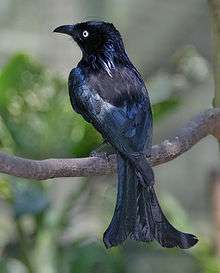Hair-crested drongo
The hair-crested drongo (Dicrurus hottentottus) is an Asian bird of the family Dicruridae. This species was formerly considered conspecific with Dicrurus bracteatus, for which the name "spangled drongo" – formerly used for both – is now usually reserved. Some authorities include the Sumatran drongo (D. sumatranus) in D. hottentottus as subspecies (Lepage 2003).
| Hair-crested drongo | |
|---|---|
 | |
| Adult in Singapore | |
| Scientific classification | |
| Kingdom: | Animalia |
| Phylum: | Chordata |
| Class: | Aves |
| Order: | Passeriformes |
| Family: | Dicruridae |
| Genus: | Dicrurus |
| Species: | D. hottentottus |
| Binomial name | |
| Dicrurus hottentottus (Linnaeus, 1766) | |
| Synonyms | |
|
Corvus hottentottus Linnaeus, 1766 | |
It is native from Bangladesh,[1] India and Bhutan through Indochina to China, Indonesia, and Brunei (BirdLife International 2008). Hair-crested drongos move in small flocks and are very noisy. The "spangled drongo," Dicrurus bracteatus is native on the east coast of Australia and its name is pejorative slang for a silly person. This may be due to its strange chattering and cackling. "Complete Book of Australian Birds" Reader's Digest.1977.
Taxonomy
In 1760 the French zoologist Mathurin Jacques Brisson included a description of the hair-crested drongo in his Ornithologie based on a specimen that he mistakenly believed had been collected from the Cape of Good Hope in South Africa. He used the French name Le choucas du Cap de Bonne Espérance and the Latin Monedula Capitis Bonae Spei.[2] Although Brisson coined Latin names, these do not conform to the binomial system and are not recognised by the International Commission on Zoological Nomenclature.[3] When in 1766 the Swedish naturalist Carl Linnaeus updated his Systema Naturae for the twelfth edition, he added 240 species that had been previously described by Brisson.[3] One of these was the hair-crested drongo. Linnaeus included a brief description, coined the binomial name Corvus hottentottus and cited Brisson's work.[4] The type locality was subsequently corrected to Chandannagar in West Bengal.[5] The specific name hottentottus is from "Hottentot", a term formerly used for the Khoikhoi, a nomadic pastoral people of southwest Africa.[6] This species is now placed in the genus Dicrurus that was introduced for the drongos by French ornithologist Louis Jean Pierre Vieillot in 1816.[7] There are 12 subspecies.[8]
References
- BirdLife International (2016). "Dicrurus hottentottus". IUCN Red List of Threatened Species. 2016: e.T103711043A95131033. doi:10.2305/IUCN.UK.2016-3.RLTS.T103711043A95131033.en. Retrieved 10 January 2020.
- Brisson, Mathurin Jacques (1760). Ornithologie, ou, Méthode contenant la division des oiseaux en ordres, sections, genres, especes & leurs variétés (in French and Latin). Volume 2. Paris: Jean-Baptiste Bauche. pp. 33–34, Plate 2 fig 2. The two stars (**) at the start of the section indicates that Brisson based his description on the examination of a specimen.
- Allen, J.A. (1910). "Collation of Brisson's genera of birds with those of Linnaeus". Bulletin of the American Museum of Natural History. 28: 317–335. hdl:2246/678.
- Linnaeus, Carl (1766). Systema naturae : per regna tria natura, secundum classes, ordines, genera, species, cum characteribus, differentiis, synonymis, locis (in Latin). Volume 1, Part 1 (12th ed.). Holmiae (Stockholm): Laurentii Salvii. p. 155.
- Mayr, Ernst; Greenway, James C. Jr, eds. (1962). Check-list of birds of the world. Volume 15. Cambridge, Massachusetts: Museum of Comparative Zoology. p. 152.
- Jobling, J.A. (2018). del Hoyo, J.; Elliott, A.; Sargatal, J.; Christie, D.A.; de Juana, E. (eds.). "Key to Scientific Names in Ornithology". Handbook of the Birds of the World Alive. Lynx Edicions. Retrieved 20 June 2018.
- Vieillot, Louis Jean Pierre (1816). Analyse d'une Nouvelle Ornithologie Elementaire (in French). Paris: Deterville/self. p. 41.
- Gill, Frank; Donsker, David, eds. (2018). "Orioles, drongos, fantails". World Bird List Version 8.1. International Ornithologists' Union. Retrieved 29 March 2018.
![]()
- Lepage, Denis (2003). "Spangled Drongo (Dicrurus hottentottus)". Avibase - The World Bird Database. Retrieved 2009-04-10. See also this more specific page.
